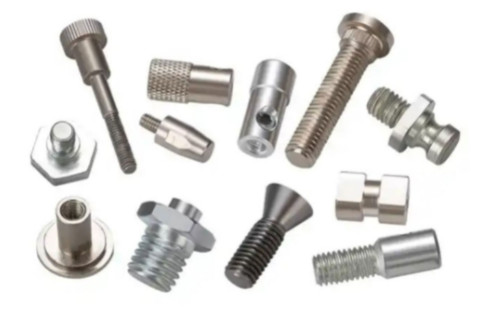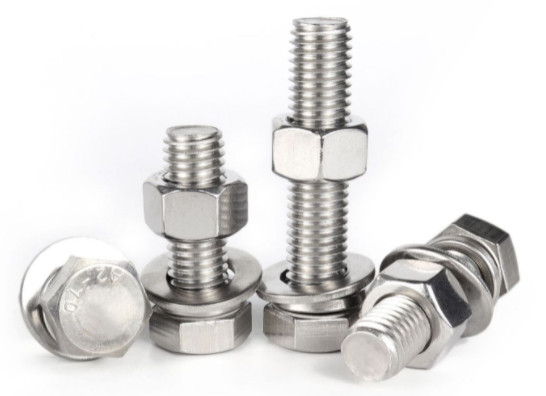Fasteners are essential components in manufacturing, providing mechanical connections for assembling parts across industries such as automotive, aerospace, construction, and electronics. These devices, including screws, bolts, nuts, washers, and rivets, ensure structural integrity by joining components securely, often in a non-permanent manner. This article explores the types, materials, specifications, and applications of fasteners, emphasizing their technical characteristics and practical use in manufacturing.
Understanding Fasteners and Their Role
Fasteners are mechanical devices designed to join two or more components together, typically creating non-permanent joints that allow for disassembly without damaging the connected parts. Unlike permanent methods like welding or gluing, most fasteners enable reversible connections, making them ideal for applications requiring maintenance or reconfiguration. Fasteners are defined by their ability to apply clamping force, ensuring stability and alignment in assemblies.
In manufacturing, fasteners are critical for assembling machinery, vehicles, infrastructure, and consumer goods. Their design and material selection depend on factors such as load requirements, environmental conditions, and the materials being joined. Fasteners vary in size, from small screws with diameters less than 0.5 mm for electronics to large bolts exceeding 30 mm for heavy machinery.
Types of Fasteners Used in Manufacturing
Fasteners encompass a wide range of components, each designed for specific applications. The primary categories include threaded and non-threaded fasteners, with threaded types being the most common in manufacturing due to their versatility and strength.
Threaded Fasteners
Threaded fasteners feature helical ridges (threads) that provide secure attachment through torque application. The following are the most common types:
- Screws: Externally threaded fasteners with a head and a sharp or blunt tip, often self-tapping. Screws engage with internal threads in components or cut their own threads during installation. Common types include:
- Machine Screws: Uniformly threaded, used in pre-drilled holes for machinery. Example: M6 x 1.0 mm thread, 20 mm length, with a tensile strength of 700 MPa (for ISO Class 8.8).
- Sheet Metal Screws: Sharp, self-tapping screws for metal, wood, or plastic. Example: #8 x 3/4" with coarse threads for thin metal sheets.
- Wood Screws: Coarse-threaded screws with tapered heads for wood applications. Example: #10 x 2" with a partially threaded shank.
- Bolts: Externally threaded fasteners paired with nuts, typically used in pre-drilled holes. Bolts have blunt tips and require pre-formed internal threads. Example: M10 x 1.5 mm thread, 50 mm length, Grade 5 carbon steel with 580 MPa yield strength.
- Nuts: Internally threaded components that mate with bolts to secure assemblies. Common types include hex nuts, lock nuts, and wing nuts. Example: M8 hex nut, compatible with ISO 898-2 standards.
- Studs: Threaded rods without heads, used for high-strength applications. Example: M12 x 100 mm continuous-thread stud for machinery.
Non-Threaded Fasteners
Non-threaded fasteners rely on mechanical or frictional forces rather than threads. Key types include:
- Rivets: Permanent fasteners deformed to join materials, commonly used in aerospace and structural applications. Example: 4.8 mm diameter aluminum rivet with 300 MPa shear strength.
- Pins: Cylindrical fasteners, such as dowel pins or cotter pins, used for alignment or securing components. Example: 6 mm diameter steel dowel pin with a tolerance of ±0.01 mm.
- Clips and Retaining Rings: Secure components on shafts or within housings. Example: 25 mm internal retaining ring for a bearing assembly.
Materials for Fasteners
The choice of fastener material impacts durability, corrosion resistance, and performance. Manufacturers select materials based on the application’s mechanical and environmental requirements. Common materials include:
| Material | Properties | Applications | Example Specifications |
|---|---|---|---|
| Carbon Steel | High tensile strength, cost-effective, moderate corrosion resistance | Automotive, machinery, general manufacturing | Grade 2 (415 MPa tensile), Grade 5 (830 MPa tensile), Grade 8 (1030 MPa tensile) |
| Stainless Steel | Excellent corrosion resistance, moderate strength | Marine, outdoor, food processing | A2 (304) or A4 (316), 500-700 MPa tensile strength |
| Alloy Steel | High strength, heat-treated, low corrosion resistance | Aerospace, heavy machinery | ASTM A193 B7, 860 MPa tensile strength |
| Aluminum | Lightweight, corrosion-resistant, lower strength | Aerospace, electronics | 6061-T6, 260 MPa tensile strength |
| Titanium | High strength-to-weight ratio, corrosion-resistant | Aerospace, medical devices | Grade 5 (Ti-6Al-4V), 900 MPa tensile strength |
Non-metallic materials, such as nylon and PEEK, are used for applications requiring electrical insulation or chemical resistance, though they are less common in heavy-duty manufacturing.
Manufacturing Processes for Fasteners
Fasteners are produced using various methods, each suited to specific fastener types and production volumes. The primary processes are:
Cold Forging
Cold forging shapes metal at room temperature using high-pressure presses. It is the most common method for standard fasteners like screws and bolts, offering high-speed production (up to 300 parts per minute) and excellent mechanical properties due to work hardening. The process involves feeding coiled wire into a press, where it is cut into blanks and formed through multiple dies. Limitations include increased force requirements for larger diameters (above 30 mm).
Hot Forging
Hot forging heats metal to improve malleability, used for large bolts (M36 or larger) or complex shapes. It allows for overlength threads but is slower and more energy-intensive than cold forging.
Machining
Machining cuts metal into precise shapes, suitable for non-standard fasteners or small batches. It generates waste (swarf) and is time-consuming, making it less cost-effective for mass production.
Thread Rolling
Thread rolling forms threads by pressing metal between dies, enhancing strength and surface finish. It is preferred over thread cutting, which severs material grains and reduces durability. Example: M8 bolt with rolled threads, achieving 10% higher fatigue resistance than cut threads.
Standards and Specifications
Fastener standards ensure quality, compatibility, and safety. The American Society of Mechanical Engineers (ASME) and the International Organization for Standardization (ISO) provide guidelines for dimensions, materials, and performance. Key standards include:
- ASME B18: Covers dimensional and inspection requirements for fasteners. Example: ASME B18.2.1 specifies hex bolt dimensions, such as a 1/2-13 UNC bolt with a 3/4" head width.
- ISO 898-1: Defines mechanical properties for carbon steel and alloy steel bolts, screws, and studs. Example: Class 8.8 bolts have a minimum tensile strength of 800 MPa.
- ASTM A307: Specifies carbon steel bolts for general applications, with grades A, B, and C based on tensile strength (e.g., Grade A: 330 MPa).
Compliance with standards ensures fasteners meet project requirements, reducing risks of failure. Manufacturers often include head markings or certification documents to verify adherence.
Applications in Manufacturing
Fasteners are integral to various manufacturing sectors, each requiring specific types and specifications:
| Industry | Common Fasteners | Applications | Specifications |
|---|---|---|---|
| Automotive | Hex bolts, machine screws, nuts | Chassis assembly, engine components | Grade 8 bolts, 1030 MPa tensile strength |
| Aerospace | Rivets, titanium bolts, lock nuts | Airframe, wing assembly | Ti-6Al-4V bolts, 900 MPa tensile strength |
| Construction | Anchor bolts, wood screws, rivets | Structural frameworks, drywall | ASTM A307 Grade A bolts, 330 MPa tensile strength |
| Electronics | Micro screws, threaded inserts | Circuit boards, enclosures | M2 x 0.4 mm screws, stainless steel |
Selection Considerations
Choosing the right fastener involves evaluating several factors:
- Load Requirements: Tensile, shear, and fatigue strength must match the application. Example: Grade 8 bolts for high-load automotive suspensions.
- Material Compatibility: Fasteners must be compatible with joined materials to prevent galvanic corrosion. Example: Stainless steel screws for aluminum components.
- Environmental Conditions: Corrosion resistance is critical for outdoor or marine applications. Example: A4 stainless steel for coastal environments.
- Size and Thread Type: Dimensions and thread pitch must align with component specifications. Example: M10 x 1.5 mm for machinery with coarse threads.
Proper selection enhances assembly reliability and longevity, ensuring safety and performance.

Conclusion
Fasteners, including screws, bolts, nuts, and rivets, are fundamental to manufacturing, enabling secure and often reversible connections across diverse applications. By understanding their types, materials, manufacturing processes, standards, and selection criteria, manufacturers can optimize assemblies for strength, durability, and efficiency. Adherence to standards like ASME and ISO ensures quality, while careful material and design choices address specific project needs.
